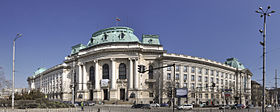- Baroque Revival architecture
-
The Baroque Revival or Neo-baroque was an architectural style of the late 19th century. The term is used to describe architecture which displays important aspects of Baroque style, but is not of the Baroque period proper—i.e., the 17th and 18th centuries.
Some examples of Neo-baroque architecture:
- The Akasaka Palace in Tokyo, Japan
- The Alferaki Palace in Taganrog, Russia
- The Ashton Memorial in Lancaster, England
- The Belfast City Hall in Belfast, County Antrim
- The Beloselsky-Belozersky Palace in Saint Petersburg, Russia
- The Bode Museum in Berlin, Germany
- The Burgtheater in Vienna, Austria
- The Christiansborg Palace in Copenhagen, Denmark
- The Belfast City Hall in Belfast, Northern Ireland
- The Cluj-Napoca National Theatre in Cluj-Napoca, Romania
- The Ortaköy Mosque in Istanbul, Turkey
- The Dolmabahçe Palace in Istanbul, Turkey
- The Elms Mansion, Newport, Rhode Island, United States
- The National Theatre, Oslo in Oslo, Norway
- The Palais Garnier (also known as the Paris Opera) in Paris, France
- The Rosecliff Mansion, Newport, Rhode Island, United States
- The Semper Oper in Dresden, Germany
- The Sofia University Rectorate in Sofia, Bulgaria
- The Church of St. Barbara (Brooklyn, New York)
- The St. John Cantius church in Chicago, United States
- The Church of St. Ignatius Loyola (New York City)
- The Széchenyi Medicinal Bath in Budapest, Hungary
- The Volkstheater in Vienna, Austria
- The former royal palace, today the National Art Gallery of Bulgaria in Sofia, Bulgaria
- Wenckheim Palace, Budapest, Hungary
- Park Club, Budapest, Hungary
- The Great Theatre of Havana, Havana, Cuba
- The Presidential Secretariat in Colombo, Sri Lanka
There are also number of post-modern buildings with a style that might be called "Baroque"—for example The Dancing House in Prague by Vlado Milunić and Frank Gehry, who have described it as "new Baroque"[1].
Baroque Revival architects
- Ferdinand Fellner (1847–1917) and Hermann Helmer (1849–1919)
- Arthur Meinig (1853–1904)
See also
References
- Endnotes
- ^ " The Dancing Building, which Frank Gehry and Vlado Milunic have described as "new Baroque", has divided opinion [...] ", in "Architect recalls genesis of Dancing Building as coffee table book published", by Ian Willoughby, 11-07-2003, online at The international service of Czech Radio
- Sources consulted
- JAMES STEVENS CURL. "Neo-Baroque." A Dictionary of Architecture and Landscape Architecture. Oxford University Press. 2000. (Encyclopedia.com. 3 Jan. 2010)
Revival styles in Western architecture and decorative arts International Baroque Revival · Beaux-Arts · Neo-Byzantine · Carpenter Gothic · Châteauesque · Egyptian Revival · Gothic Revival · Greek Revival / Neo-Grec · Moorish Revival · Neoclassical · Renaissance Revival / Italianate · Romanesque Revival · Second EmpireBritish Empire Bristol Byzantine · Edwardian Baroque · Indo-Saracenic Revival · Jacobethan · Queen Anne Style · Scots Baronial Style · Tudor RevivalFrance Germany Greece Portugal Russian Empire and USSR Scandinavia Spain United States Jeffersonian architecture · American Renaissance · Colonial Revival · Mayan Revival · Mediterranean Revival · Mission Revival · Pueblo Revival · Queen Anne Style · Richardsonian Romanesque · Spanish Colonial Revival · Territorial Revival
This art movement-related article is a stub. You can help Wikipedia by expanding it.




